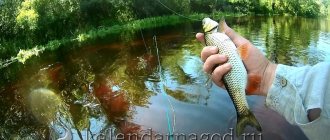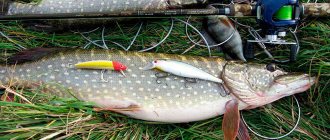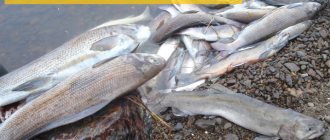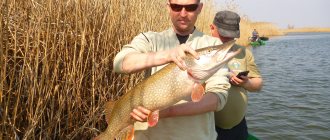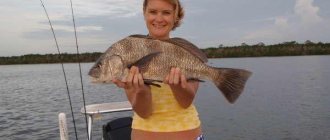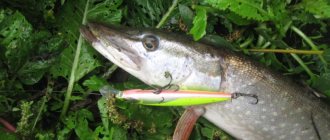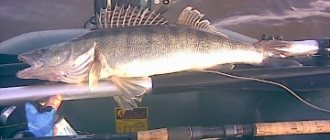Since the advent of fishing, attempts have been made to learn how to predict the activity and behavioral characteristics of fish, and, accordingly, the possible catch. Many factors have been identified, from those that clearly influence the behavior of residents of reservoirs to those that are quite dubious. There is no unanimous opinion among fishermen about how the moon affects the pike bite. Some fish exclusively on those days that are considered favorable according to the lunar phase, while others pay more attention to weather conditions and time of year, and do not attach importance to other factors when planning fishing trips.
Many factors affect the pike bite
Relationship between the phase of the moon and the activity of predatory fish
The Moon is the closest celestial body to Earth; the influence of its mass and magnetic field on our planet is difficult to deny. However, the answer to the question of how the lunar cycle affects the inhabitants of water bodies is somewhat more complicated. According to the observations of many fishermen, the pike bite according to the phases of the moon will look something like this:
- New moon. At this time, the Earth's natural satellite is either not visible at all in the night sky, or only its narrow crescent can be seen. Fish activity is unstable, many anglers at this time point to a weak bite, while others, on the contrary, believe that at this time there is the greatest chance of decent catches.
- First quarter period. At this time, fish activity is at an average level; under favorable weather conditions and time of year, it is quite a good time for fishing, although the chances of catching a trophy are not the highest. However, many pike hunters point to increased activity of the predator in the first days of the quarter.
- It is especially important to understand whether pike bite during the full moon. Most anglers tend to believe that this phase of the lunar cycle has the least favorable effect on pike fishing. It will be difficult to catch predatory fish at this time, but if other factors are favorable, then you can count on some kind of catch.
- The time of the last quarter of the lunar cycle, especially the first and last days of this period are considered the most favorable. The pike bite should be active, especially if the weather at this time is favorable, fishing in this case should be especially successful. The main thing is to catch a predator using the bait that is most attractive to it in a particular body of water.
Pike behavior changes depending on the phase of the moon
How weather and moon phases affect pike biting
Today we offer the topic: “how weather and moon phases affect the pike bite” from professional fishermen. We tried to cover the topic as fully as possible. You can ask all questions in the comments after the article.
Pike is the fish that seduces many fishermen, who do everything possible to not only catch it, but also catch a good trophy. It must be said that this happens with varying degrees of success, although the fish can be found in many reservoirs and they bite quite well.
True, at the same time, there are days when it seems that the fish eats almost everything that is offered to it, and there are days when it does not even swim up, despite the fact that it is offered the most delicious delicacies. Many experienced fishermen note that this happens because the phases of the moon influence the fish in a certain way. It’s impossible to say for sure whether this is true, but having understood the issue a little, you can at least know approximately when to go fishing.
There are anglers who have compiled their own pike fishing calendar, where they indicate when it is worth fishing for toothy pike, and when attempts are in vain. It must be said that fish have two peaks of activity. The first lasts from the first to the seventh lunar day, and the second - from the seventeenth to the twenty-first.
If anyone doesn’t know, the lunar month begins when the moon is not visible in the sky, that is, the new moon occurs. Only then does the sickle appear, and it begins to gradually become rounder. At the first stage, you can notice a half-disk, and then a full moon. So, two days after the full moon comes the 17th lunar day.
Important! It is believed that the worst bite is immediately after the full moon. And it lasts for two to three days.
As already mentioned, some fishermen even have a pike fishing calendar that they use as a guide.
True, it is worth saying that the moon influences most of all those waterfowl that live in small bodies of water into which rivers or rivulets do not flow. At the same time, pike, which lives in large bodies of water, may either not respond to the new moon or other phases, or react, but rather weakly.
There are fishermen who note that the moon is, of course, good, but it’s not just about it. The hydrological regime of the reservoir, its size, weather, as well as the skill of attracting fish and then catching them also play a huge role.
Therefore, maybe there is some kind of impact, but if there is no knowledge of how and with what to go fishing for pike, then it is not advisable to blame the fish alone for everything.
If you want to look like the moon, then you can do it, but you should also pay attention to weather conditions. Unlike people, pike, for example, perfectly sense when a magnetic storm is approaching. Moreover, she knows about it a couple of days before it starts. During this period, predators begin to actively feed, as before bad weather, cold weather, etc.
If it’s cloudy outside and the sun is showing slightly, a slight north or west wind is blowing, it doesn’t matter whether this happens on a full moon or not, you can safely go and try fishing. If there is still a light drizzle, then this is generally good.
A decrease in atmospheric pressure or pressure that is at the same level is another good indicator that the pike can actively make “contact”. Experienced people have noted that before a thunderstorm, fish can begin to actively swim even to the shore. At this moment, you need to stock up on good bait and wait until the trophy is hooked.
At the same time, if in winter the temperature drops quickly and sharply towards severe cold, then you can safely stay at home, because the pike will hide in its den and wait for the weather conditions to improve. The same applies to a clear sunny day, but with a strong northeast or east wind. Although, if the weather is stable and there is severe frost outside, then you can try your luck and go fishing. Some fishermen say that at this moment there is a good bite.
Important! If the street suddenly gets warmer, the air temperature immediately rises by 12-15 degrees Celsius, then the pike not only begins to peck, it actually does not come off the hook.
Of course, something like this should be used.
It must be said that in addition to the influence of the moon on pike biting, as well as the influence of weather conditions, the water level, or rather its change, also plays a big role. If the fish lives in reservoirs where water is sometimes released, then it will not swim up and feed for several days.
Many fishermen also notice that the bite depends on the time of day. During cold times of the day this happens somewhat less frequently, but, nevertheless, fish can be observed based on bites. As the weather warms up, pike come out to feed more and more often. At the same time, she can sometimes peck actively, and sometimes not.
When the weather is good, the fish bite well 1.5-2 hours before it begins to get light. After this, she may disappear somewhere for a couple of hours, and then again please with a bite around 10 am, which ends by noon. Then you can observe the second wave, starting around two or three o'clock in the afternoon and lasting until sunset or extending for another hour after the sun has set. Sometimes pike bite well at night.
Despite all of the above, it should be noted that sometimes all the above rules do not apply or work, but only exactly the opposite. Not a single fisherman can say what this is connected with. Therefore, if you have a fighting spirit to go and catch a trophy, then you should do it, showing everyone that the main thing in fishing is not the moon, but the desire to fish and do it perfectly.
Hunters of toothy predators from the ice are always interested in the question of what weather the pike bites in winter. The bite of this fish is poorly predictable; usually fishermen act at random, hoping to get into the presence of a predator. However, pike is one of those fish that are dependent on the weather. And knowledge of various aspects of the influence of environmental conditions on the activity of this fish is another plus in the theoretical baggage of a winter angler. Yes, there are no clear answers, but the general trends in the influence of atmospheric pressure and moon phases will help the fisherman. There is essentially no better weather for pike fishing in winter. In various situations, the predator acts based on living conditions. Combining this knowledge with the right fishing tactics increases the likelihood of a successful fishing outcome.
What weather is best to catch pike in winter? And this question is wrong. After all, the fisherman has already arrived for fishing anyway, and the belief that there won’t be a bite today due to pressure or the phases of the moon only weakens motivation. The right question is whether the pike is active today or passive due to the influence of natural factors, when a predator might come out to feed, etc.
Here are phrases familiar to every winter road user, which can be found in articles about cool weather:
- When the atmospheric pressure increases, the pike goes deeper, and when the atmospheric pressure decreases, it goes into shallow water.
- The best weather for biting is cloudy, light wind or calm.
- The best atmospheric pressure is stable, without sudden changes.
It is impossible to say for sure that in this particular weather it will bite, but not in another. Of the proposed phrases, only the last one is correct - indeed, the absence of pressure surges has a good effect on the bite. Moreover, it is not the atmospheric pressure itself that affects the inhabitants of the reservoir, but the weather in a broad sense. There is a myth circulating in the fishing community that changes in atmospheric pressure affect the ability to dive and ascend by affecting the fish’s swim bladder. Because of this, underwater inhabitants are forced to move up or down to level out. It is not true. Indeed, with a sharp jump in pressure even by 10 mm of mercury, in order to level it in the bubble, the fish needs to change the horizon of its position in the water by only 10 centimeters. In this case, the fish often either sinks to the bottom or floats up to the surface and does not experience any discomfort. The effect of pressure on pike biting in winter is minimal; it is simply an indicator of a certain weather condition. Pressure in winter for pike is not an impact factor, but a descriptive value for the state of the atmosphere. Read more about this in the article: https://podlednik.ru/lovlya_zimoj/rybalka/davlenie
Moon phase and pike activity depending on the size of the predator
Pike fishing, according to most anglers, depends not only on the period of the lunar cycle, but also on the size of the predator. Many note that the larger the pike, the greater the influence the Earth’s natural satellite has on it. However, it is also important to take into account that trophy-sized pike, in addition to the influence of the lunar cycle, are also more sensitive to weather conditions, and are also more picky about the baits offered.
The bite for pike by the moon can also be predicted depending on the bait used. Fishing with live bait, for example, with girders in winter or with mugs in summer, can be more effective than fishing using exclusively artificial baits. It is also important to take into account the weather conditions on the day of fishing; this may slightly shift favorable periods.
Obvious contradictions
Comparing lunar fishing books published in different countries, such as Slovakia, Czech Republic, Finland and others, you can find that they contradict each other. Therefore, the task was set: to analyze a significant amount of information about catches in order to identify the real relationship between the bite and the phases of the Earth’s permanent satellite.
The initial statistical material was the information from one fishing diary, which was kept for 10 years, and the role of the main object of the study was played by a river toothy predator - namely, pike, because It is this inhabitant of Russian reservoirs that reacts more strongly than others to the lunar phases.
The tasks were formed as follows:
- Find out the correspondence between the planned and actual number of fish caught.
- Find patterns in the influence of lunar phases on the actual catch.
The most intense eating was assessed with the highest rating (+3), the complete absence of bites was assessed with the lowest (-1), in other cases intermediate ratings were given (0, +1, +2). And at the end of each lunar month, the total estimates were calculated. The resulting amount was statistically processed on a computer. It turned out that during one lunar month two periods of active pike feeding : inclusive from days 1 to 7 and from days 17 to 21.
Influence of season on fish activity
Experienced fishermen, thinking about what affects the pike’s bite, start not with the influence of the Earth’s natural satellite, but with the season when fishing is ahead, since during active spawning, even the most favorable phase of the Moon will not force the toothy predator to take bait well.
It is quite predictable that the most favorable times of the year for pike fishing are spring and autumn, while in the summer it can be more difficult to effectively catch pike. For many anglers, spring is one of the most productive periods when it comes to pike fishing. However, at this time it is important to catch the relatively short periods of pre-spawning and post-spawning feeding of pike, when the predator shows maximum activity and rushes to almost any bait offered by the fisherman. It is worth remembering that if you get to the spawning period, then most likely you should not count on a catch, the fish will not bite at this time.
Depending on the fishing season, the fish will behave differently
For most anglers, autumn is the most interesting time for pike hunting. The predator, sensing the approach of cold weather, begins to actively feed, and only the most unfavorable weather conditions can ruin its appetite at this time. It is in the fall that the entire arsenal of artificial baits works great - wobblers, in all their diversity, rotating and oscillating spoons, edible silicone. The activity of pike begins to increase already in September, with the beginning of a decrease in temperature, and reaches a maximum in October.
Other factors
The phase of the moon is only one of the few factors that influence the bite. Therefore, you should not pay excessive attention to it. And some fishermen believe that the size does not depend on the Earth’s satellite at all The activity of pike is greatly affected by :
- pressure and its changes;
- wind strength and direction;
- the number of clouds in the sky and precipitation;
- air and water temperature.
When planning a fishing trip, spinners pay attention primarily to these factors . This approach makes sense , since the weather can really have a decisive influence on the bite .
But if you also take into account the phase of the moon , your chances of success increase significantly . Conduct your own experiments and determine whether the period of the lunar cycle matters on the size of your catch. Every true spinner enjoys understanding the behavior of his potential trophies and finding out what motivates them. And studying the influence of moon phases on biting will come in handy here.
Increase in atmospheric pressure
With a change in blood pressure upward, the pike loses all interest in food and does not bite at all. Even when she is hungry, she may not show interest in the schools of small fish scurrying around her. Therefore, the zhor wakes up just at the little thing, which takes advantage of the moment.
During this period, the basis of the pike’s diet is insects, worms, sick fish, etc. Therefore, for successful fishing, you should use flies, spinerbaits, artificial or natural frogs, and twisters. In this case, the predator’s target will not be the bait, but any tripe floating nearby.
At dawn and late in the evening, pike activity increases slightly, so the retrieve should be done more slowly. Why does pike become more active when pressure drops?
There is a suspicion that a drop in blood pressure signals the predator about an approaching cyclone. Therefore, she eats for future use so as not to starve due to bad weather.
Read Trolling for beginners and choosing gear
I hope the information presented has helped you understand what Pike Weather is. And also find out the most successful periods for catching the desired trophy, so that you can always return from the “hunt” with a rich catch!
Where to look for pike in the lake
Lakes, unlike rivers, do not have a pronounced current. Masses of water move extremely rarely - this happens only with a large influx of melt and storm water into the reservoir. The rest of the time there is no current in the lakes. This fact greatly simplifies the search for pike. And if in rivers and deep streams the predator constantly changes its parking places, then in the lake the pike leads a sedentary lifestyle.
Lake pike loves most all kinds of bottom irregularities (pits, depressions, plateaus in the depths), flooded snags, bushes, areas near aquatic vegetation, grass islands). In such places, pike waits for small fish swimming past and hides from the summer heat.
Very often, the presence of a pike in a particular place can be determined by the characteristic splashes with which the predator accompanies each of its attacks.
Optimal atmospheric pressure for fishing
For pike
- the best time for biting, in the warm season, is when the pressure gradually decreases (cyclones are approaching);
- in the middle of summer, with almost always high pressure, the bite is worse than at other times of the year. It is better to fish in summer during short-term, morning or evening drops in pressure;
- Even a decrease in atmospheric pressure by 2-4 mm leads to increased biting. rt. Art. after an increase or persistently high atmospheric pressure;
- the lowest point of pressure before increasing is most likely for active biting;
- the period of increased pressure, after the stabilization phase of low pressure, is characterized by indifference to the usual food items. Pike reacts to slower victims - sick fish, frogs, offal, etc.;
- with an increase in pressure and the departure of the main food sources to the upper layers of water, the pike switches to ambush hunting;
- at low pressure avoids shallow water;
- in autumn, cloudy weather with drizzling tedious rain is optimal for pike fishing;
- In winter, pike are most active during periods of low atmospheric pressure, which are commonly called thaws.
For crucian carp
- most dependent on changes in atmospheric pressure. With long-term high blood pressure, especially in summer, it is capable of hibernating and switching to skin respiration. The second behavior option can be considered the rise of schools of crucian carp into the upper layers of water and an almost complete refusal to feed;
- After a long cyclone, the bite is revived by a gradual increase in pressure. It begins to actively manifest itself at the beginning of the anticyclone;
- at normal pressure in the upper layers of water it rarely feeds;
- stable warm weather with low atmospheric pressure (gray days) moves crucian carp to depths, where it continues to feed all day;
- A short-term drop in pressure, such as a summer thunderstorm, can activate the bite. Fishing should be done in deeper and more remote places, mainly with animal bait. This drop in pressure should be preceded by persistent hot weather. Immediately after a thunderstorm, the bite of large crucian carp stops.
For carp
- The most favorable moment for carp fishing is the change of atmospheric fronts. Such a period is the period when a high pressure area approaches to replace a low pressure area;
- As a predominantly bottom-dwelling fish, carp are sensitive to the presence of oxygen in the water. With prolonged high atmospheric pressure, especially in the absence of wind, the flow of oxygen into the lower layers of water is not significant. Low pressure brings wind and rain, which, mixing the water, fill it with oxygen;
- The ideal pressure for carp is below 750 mm. rt. Art. At higher pressure, carp stay in the upper layers of water and at shallow depths. At low pressure it goes to the bottom to depths.
It must be said that the fish bite is most likely influenced not by atmospheric pressure separately, but by the whole complex of weather processes and seasons. Fish are also susceptible to geomagnetic disturbances of the Earth. The precise influence of specific factors of weather change, including atmospheric pressure, on fish biting has not yet been studied by science. The influence of changes in weather processes as a whole has been more or less studied. However, in each body of water, in each area and in relation to each specific fish, everything happens differently. The fisherman is forced to adapt to the fishing conditions.
In what weather does it bite better?
So what is the best weather for fishing? Let's summarize all of the above.
Summer
Photo 6. Summer heat is not the best weather for fishing, because at this time the water “blooms” and the oxygen content in it decreases.
- The best fishing in summer will be when dry, cool weather without strong winds has established for two or three days. The maximum bite is usually observed in the morning and evening hours - on sunny days, or throughout the day - if it is cloudy. If the heat sets in, the duration of the bite is noticeably reduced, and then it completely disappears. But when it gets cold, the fish suddenly stop biting.
- Short-term but heavy rain and thunderstorms have a positive effect on the bite, especially after a long heat. If the elements drag on, then fishing will only be at the very beginning, then the lack of bite will come.
Autumn
- The best weather for fishing this season is, again, quiet days without precipitation and strong winds. But before the freeze-up, the fish gradually move away from the shores - to the deepest places.
- In the fall there is nothing to do when fishing in bad weather. However, at this time, fishermen specializing in “freshwater cod” have the largest catches. According to them, the worse and slushier the weather, the better the burbot bites.
Read Lures for pike fishing
Winter
Photo 8. In winter, the best weather for fishing is clear, with light frost.
- The most preferable weather for fishing in winter is clear days with light or moderate frost (usually this happens at the beginning of freezing). At this time, perch, pike perch and pike are especially well caught. If within several days the thermometer does not rise above -30°C, there may be a noticeable weakening of the white fish bite, even to the point of its cessation. Complete lack of bite can be observed if the sky suddenly becomes cloudy and a strong snowstorm begins. However, at the very beginning of bad weather, bursts of fish activity are possible; it has also been noted that burbot really likes bad weather (don’t forget that this fish spawns in February).
- Among Ural fishermen there is an expression “Chebach weather”. It means a thaw after frost, during which the snow on the roads becomes sticky, necessarily with a cloudy sky, a quiet breeze and heavy snowfall. Indeed, in such weather in our area, the winter roach bites like a demon. Although, other white fish (for example, bream) are also active.
- At the very end of the freeze-up, the south wind can bring real heat - then intensive snow melting will begin, which will immediately “start” the bite, even if there was a complete dead winter.
Spring
Photo 9. In spring the weather is just right for fishing, but everything is complicated by high water.
- In spring, fishing is seriously complicated by high water. Nevertheless, between the melting of the ice and the actual flood, good fishing in open water is often observed on warm sunny days.
- Don't forget about burbot. As long as the water temperature does not rise above 12°C, it can be successfully caught using bottom gear at night.
Why do you need a fishing forecast?
Although fishing is considered recreational, it should be productive. Returning home without a catch is insulting, annoying and embarrassing. You should not rely only on personal experience. To help an experienced fisherman, and especially a beginner, a bite forecast for 5 days combined with useful weather reports.
Read How to wind fishing line on a spinning reel
Using an interactive map, weather and bite forecast, you know exactly whether the fish will bite in the coming days, whether it’s worth going fishing or whether it’s better to wait. But a real fisherman cannot be frightened by either cold or heat. Once he decides to fish, it is impossible to stop him. If you can’t reschedule your fishing trip or don’t want to, the bite forecast will help you choose the right place where the fish will definitely bite these days.
Even if you keep a diary where you record the weather conditions when there was a good catch, it is very difficult to predict the bite on your own. It’s not for nothing that scientists engage in complex calculations and use modern instruments. Only a scientifically based bite forecast will give results.
